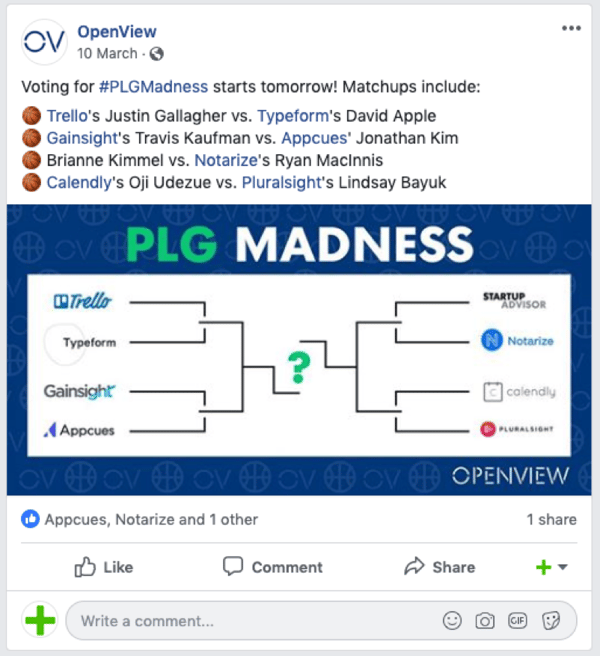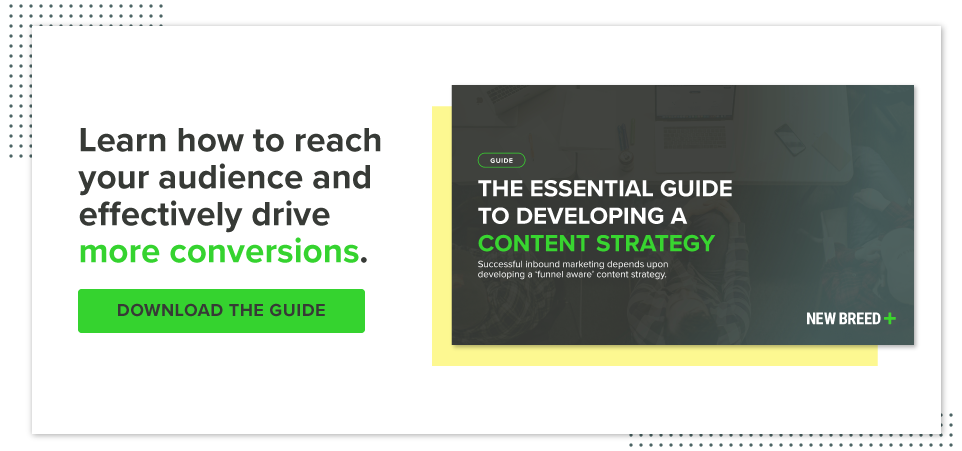Boost The Value Of Your Content With These 7 Promotional Strategies
Content marketing is a key component of the inbound methodology — but if the content you’re creating is never consumed, shared or downloaded by your audience, then it won’t make any significant impact on your marketing goals.
“There are three main phases of marketing that should always be occurring,” says Guido Bartolacci, New Breed’s Head of Demand Generation Marketing. Those three phases are:
- Planning: During this stage, you develop your strategy, including the amount and types of content you need to create.
- Production: During this stage, you actually create that content, which could include writing, filming, designing and more.
- Promotion: During this stage, you push your content out to different channels to get as many eyes on it as possible.
In this blog post, we’ll focus on the promotion stage of content marketing. We’re going to use blog content as an example for the many ways you can promote that content, but these strategies can be adapted for premium content offers, videos, guides and more.
7 Promotional Strategies to Amplify Your Content
- Search Engine Optimization for Organic Growth
When you publish a new blog post, the first step to putting it in front of your audience is making sure it’s SEO-optimized. When Google crawls and indexes your page, it’s more likely to be found through organic searches.
However, getting your site indexed can take anywhere from four days to four weeks, and its performance could dip over time if you’re not consistently optimizing it for its relevance, timeliness and keywords. That means SEO strategy is a type of passive promotion, so you shouldn’t rely on it as your sole promotional technique.
“[Getting indexed by Google] is just going to happen and will likely grow over time,” says Guido. “But you need to work on promoting your content outside of that as well.”
If you manage and publish your content on HubSpot, for example, then it automatically gets added to your site map and indexed by Google, so there’s no additional work you need to do outside of simply clicking “publish.”
- Email Blasts to Engaged Subscribers
According to this study by Campaign Monitor, you’re six times more likely to get click-throughs from an email than you are from a social channel like Twitter.
Why? Because email subscribers are already engaged with your brand.
“Ideally, these people have subscribed to your blog to learn more about who you are and to be educated by the content you’re creating,” explains Guido. “So you need to get your content in front of them first.”
Again, marketing automation tools like HubSpot can help you automate this process, and built-in personalization tools can help you retain that human touch.
- Social Posts to Meet Prospects Where They Are
From LinkedIn to Instagram, social media sites offer a powerful channel for engaging with prospects, humanizing your brand and promoting your content.
Share your content on every social channel relevant to your personas. Almost always, those channels will include Twitter, Facebook and Linkedin, but it ultimately depends on the unique online behaviors of your ideal buyers.
Social posting can also be automated using tools like HubSpot. “But if you start connecting your marketing automation platform to multiple social accounts, then you’ll start to see the same post go out from multiple team members,” says Guido, “which can look a little funny. So if you’re looking to get a bit more engagement and personalize your brand, then manually writing and posting on social has its benefits as well.”
Additionally, social groups exist for almost every area of business, and promoting your content within these groups can be valuable because they make up a more targeted, contextualized audience.
“The last thing with social that can be super beneficial is tagging influencers,” says Guido. Tagging influencers and encouraging them to share your content can be made more feasible by creating content like:
- Round-up posts
- Influencer profiles or interviews
- Product reviews
- Content Syndication to Reach New Audiences
Asking other leaders in your space to republish your blog content on their website is a great way to expose your content to new and interested audiences.
“New Breed gets our blog content syndicated on OpenView, which is super helpful for us,” says Guido. “We use a canonical tag which tells Google that our post should rank — so we don’t experience any issues with duplicate content.”
This strategy has mutual benefits for each company because they get to post a fresh piece of content on their website without much effort on their part, and we get to promote our subject matter expertise to a new audience.
However, without the ability to use a canonical tag, you could run into issues with duplicate content and have your republished piece outranking the original blog page. This problem tends to arise when you’re posting on websites that allow user-generated content like Quora or Medium.
Avoid this by altering your post slightly when you post to websites like these. Instead of republishing the full post, change the title slightly, condense the content and end with a teaser link to view the full post on your website.
- Guest Posting for Mutual Promotional Benefit
“Guest posting in itself is a great way to amplify your brand,” says Guido, “and one of the things you can do is write a guest post in a way that promotes another piece of content you have to drive readers to your website.”
For example, New Breed could publish a post about SaaS marketing on an industry-related website, and then link to our guide, “The Definitive Guide to SaaS Marketing.”
Remember, though, guest posting should offer mutual benefit for both parties, so you can also solicit guest contributions from other professionals in your industry. When they post an original piece of content on your website, they’re likely to share and promote it to their own audience, so you’re still driving new visitors to your website.
- Paid Ads and Remarketing to Bring Readers Back
“Paid ads and remarketing are typically going to be used to promote a gated content offer,” says Guido. “The reason for that is because you’re paying for that traffic, so you want to get as much value out of it as possible — and one of the best ways to do that is by collecting their information through a form.”
At New Breed, for example, we exclusively promote content offers via paid, not any of our bottom-of-the-funnel offers like free assessments. Of course, that’s not going to be the same for every company.
Companies with frictionless funnel — for example, those with a product-led growth strategy — might be able to promote free trials and demos through paid ads and remarketing.
But if your sales process is a bit more complex, it may be worth pulling people into your funnel at the awareness stage and then nurturing them through.
- Contests for Added Hype and Engagement
Contests might not be the obvious choice for content promotion, but they can be a powerful tool for creating and soliciting content that almost promotes itself.
For example, OpenView recently did a March Madness-esque contest about product-led growth. They solicited submissions from different companies about their product-led growth strategies, and the top-performing posts were compiled into an e-book at the end.

Companies that entered the contest were more likely to promote their submissions and, in turn, drive their audience to OpenView’s website.
Bonus Tip for Content Promotion: How do you choose which pieces of content to promote?
“If it’s a net-new piece of content, promote the hell out of it,” says Guido. “You’ve just spent all this time and energy on creating it, and you can’t just let that go to waste.”
That will also give you a sense of whether or not your new content actually resonates with your audience. If it does, you might want to consider creating more content on that topic.
For older content, you should lump pieces into three categories:
- High-performers
- Medium-performers
- Low-performers
You should be constantly working your high-performing content into your regular promotional process. Your high-performers won’t always be your latest, freshest content, so be sure to loop them into your email newsletters, social shares and other promotional strategies from time to time.
For example, New Breed’s top-performing post was originally published in 2016, but it continues to drive new traffic to our website.
Medium performers should be revisited and re-optimized periodically to try to push them into the high-performing category and get more value out of them. Every time you re-optimize a piece of content, loop it back into your overall promotional strategy.
Lastly, low performers should be taken out of circulation over time.
“At New Breed, we noticed that we had two premium content offers that were consistently converting leads, so they appeared to be high-performers,” says Guido. “But literally nobody who converted on those offers ever became customers, so in reality, it was a low performer for us. We decided to un-gate it and convert it into a blog post so it would continue to drive traffic to our website.”
That’s not always how you’ll want to deal with low-performing content, however. In some cases, you have to face the fact that a specific piece of content simply isn’t driving value for your company and be willing to take it off of your website.
When it comes to blog posts, for example, Google’s ranking algorithm considers your domain in its entirety. If there are a high number of posts that nobody engages with, that can hurt your domain authority overall.





